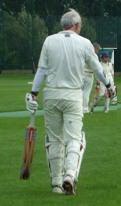 |
| Bad light - Scotland 9.00 am |
But year after year this appeal is made and pages of the popular press are filled with the concept of an extra hour of daylight. Who would not want an extra hour of daylight? But this is a trick, there is no extra hour to be had, just the same hours and same amount of light. In the North of Scotland maintaining BST through the year would mean that it would not get light until goodness knows when. Play could not begin until well after lunchtime.
 |
| Bad light - Durban 2004 |
But the present situation has come about to avoid military confrontation between nations. For light used to be subject of a high level of gamesmanship when it was in the interests of one team to suspend play. Appeals would pour out of batsmen who would grope around in the half light to make the point. Then when the rules were changed, there were many batsmen who practiced the additional skill of soliciting an offer of light. But no more.
Perhaps the most celebrated instance of light-centered gamesmanship came during England's tour of Australia in 1946-47 After tea on the second day of the Second Test Australia were 24/1 on a wet wicket much suited to the England bowling attack. Sid Barnes made a series of appeals against the light - up to 12 were counted - 8 in a 11 minute period. Eventually the umpires gave in to the constant appealing and the batsmen were allowed to retire an hour before stumps After the series Barnes admitted that he could have played on but the match situation lead him to 'keep on appealing until the umpires answered me'.
 |
| Barnes and Bradman on their way to 234 each |
In the Third Test Barnes appealed for light at the end of the second day, which was rejected. In the final half hour of this Test England batted on when Australia wanted three wickets for their third victory of the series Hammond had been dismissed earlier, but refused to let his team appeal against the light which in the falling rain was generally described as atrocious. Contemporary reports suggest that Hammond acted so as to make a point about Barnes' earlier behaviour. Who knows?
Barnes had a reputation as an eccentric and was frequently the subject of controversy. His later life was badly disrupted by depression and mental health problems and he died in 1973, possibly at his own hand. But gamesmanship and his colourful behaviour aside he was a great batsman - his average of 63.05 in 19 innings ranks him as number three in the history of Test cricket. But he never had to contend with bad light.


No comments:
Post a Comment